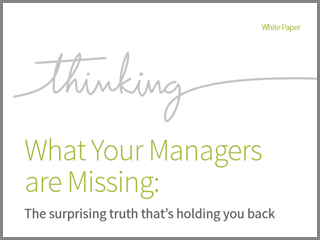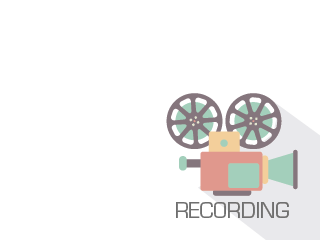All Resources
Creating Interactive Videos from Really Boring Talking Heads, Lectures and Demo Videos
Most videos in training and elearning are talking heads, lecture-type presentations or demonstration of a product or process. Case in point: your training director suddenly decides that it is good for the CEO to present an idea.

Measuring the ROI of Informal Learning
Organizations are finally realizing that people learn more of what they need to be effective at their job through informal channels, on-the-job experiences and coaching than they do through more formal means. When it comes to developing and executing the learning strategy, however, companies continue to look at things completely upside-down. The vast majority of the learning delivered within organizations is through formal classrooms and e-learning courses, which only accounts for about 10% of the learning that occurs. Even within that 10%, retention rates for single, formal learning events are abysmal, with most learners forgetting close to 90% of what they learned over time.
What opportunities are companies missing to help people retain more of what they are learning and discover new knowledge through other, more informal channels?
Nurturing Emerging Talent
A 2012 report by Deloitte identified eight trends in human capital that will have the most business impact over the next 18 to 24 months. One of the trends identified was the development of next generation leaders.

DESIGNING LEARNING THAT WORKS - Using 70:20:10 effectively
THE 70:20:10 FRAMEWORK
More and more businesses are adopting 70:20:10 to help build organizational strength. However, a question often posed is whether the approach is a theory of workplace learning, a way of cutting down on training costs, or a mantra to be followed slavishly.
Alternatively, is 70:20:10 simply ‘old wine in new bottles’ given that most Learning and Development (L&D) professionals think they already combine learning and work?
Some ask ‘why bother with 70:20:10 at all’?
Additionally, ‘what is it with this neat formula - 70, 20, 10’? People are suspicious of nice round numbers. Surely the reality of learning and performing is much too complex to be described in terms of simple ratios?
Despite all these criticisms, there’s a worldwide movement of L&D professionals who realize and acknowledge the value of 70:20:10.
This is not because it’s a mantra, an ideology or an end in itself, but because it enables them to connect more quickly and effectively to what really matters: learning and performing at the speed of business. Their work isn’t just about providing formal learning solutions. By using 70:20:10 as a reference model, more and more L&D professionals are co-creating solutions with their business
colleagues.
This ‘movement’ and new way of working with 70:20:10 makes L&D more relevant to their organizations.
CLOs and Training Leaders: When Design Really Matters, Picking Our Battles
If you’re a CLO or training leader you realize there are times when your clients are just checking-the-box and a death by PowerPoint is what they want. Part of being a leader is having a track record for results and - knowing what battles to pick. This means you can identify projects, initiatives, and curricula that really must - deliver results. And, you can develop sponsors who value the investment and are open to collaborating on a genuine training solution.

What Your Managers are Missing: The surprising truth that's holding you back
You want your managers to deliver results. Not just any results - you’re looking for breakthrough results. In order to get that done, they must be viewed by their teams as smart, likable, hard working, and caring. But there’s another quality that can make or break a manager’s pursuit of success.
Managers can only get their teams to execute the strategy successfully if they start with themselves. They must understand the strategy itself and see how internal/external forces and trends impact the business. They must know the customer needs and requirements, as well as be a role model of the culture, behaviors, and values of the organization.
This paper will help managers discover, synthesize and internalize these critical qualities.
Download Below.
“Small Bites” Learning
A study by eLearning News suggests that there is an increasing number of workers and employees who learn while on the job. Coupled with smartphones, tablets and laptops, learning and accessing knowledge becomes "use as you go" or "learn as you work."

Making the Business Case for Learning Content Management
Content is the backbone of learning. Without the right pieces in place, your learning efforts — no matter how well intentioned — will fall flat. View this Lightpaper and learn how your organization can: personalize the learning experience, efficiently author content, be more agile, and drive performance.
L&D Emerging Measurement Practices: From Executive Reporting to "Instant Insights"
This presentation will share the latest topics on the minds of L&D practitioners as it relates to emerging measurement practices including executive reporting, big data, social learning, scrap learning, strategic program measurement, prescriptive "Instant Insights," and building a business case for analytics. Glimpse into the latest trends and challenges on the minds of thought leaders and practitioners and glean creative insights to augment your learning analytics strategies in now and beyond.
Feel Like the Mobile Learning Wave has Already Left You Behind? Cut Through the Hype and Get a Real Jump Start!
A lot has been said about mobile learning and how it has already taken enterprise training by storm. However, it has become quite challenging to separate the noise from facts. If you are planning to roll-out your mobile learning initiative or even if you are already a veteran, you should join us at this webinar.

A Perspective on Competencies
A Perspective on Competencies by Hale Associates.
Why Your Training Development Team is Getting Bad Information… and How to Fix It
Content is only as good as the input your training development team uncovers to create it. You have skilled developers but if they aren’t getting the information they need their content will miss the mark.

Six Secrets To Experiential Learning
Experiential learning presents a highly unique growth opportunity for participants, as well as a tool that planners can use to achieve a specific outcome. Differentiated from more traditional team-building, experiential learning uses a blended approach to learning, integrating activities, exercises, adventure elements, quiet time and ongoing post-event coaching to create powerful programs of leadership development, strategic planning, mentoring and coaching, communication, feedback and observation as well as enhancement of behavior styles.
The Next Generation of Learning Content Strategies - Learning Content in the Age of YouTube and Facebook
Every organization that delivers employee training and development programs must deliver learning content. It’s not an optional part of training programs; in fact the content should be the central or most critical part of every employee development initiative. The challenge in today’s world is that traditional approaches to content might no longer help organizations find, develop and deliver the right content to the right employee at the right time.
Beyond The Sales Process
Beyond the Sales Process focuses on the frontline of engagement with customers. It is specifically intended for salespeople, account managers, their managers, and sales leaders, as well as others who have responsibilities and pressures associated with developing and winning business, and those who are tasked with extending and expanding their relationships with customers.
Agile Project Management for Learning Projects - LLAMA!
Either by design or by default, your team’s environment and work practices are reflected in the level of service you deliver to clients and customers. New technologies, rising expectations and shrinking budgets challenge us all to new levels. How do you keep your project from falling short in delivering on time and in budget when things are constantly changing?

Rethinking Your Performance Management Program
"Performance management" sounds wholly positive. After all, who can argue with better performance? And effective performance management (PM) programs can deliver significant, tangible benefits such as:
Increase in time spent on strategic priorities
Improvement in employee productivity
Jump in project completion rates
More decrease in turnover

Talent Magnetism: How to Create a Workplace That Attracts and Keep the Best
Talent Expert and bestselling author, Roberta Matuson explains how to navigate the changing talent pool and the challenges of attracting top talent that will stick around. The impact of extraordinary workers—ambitious, driven employees who can be counted on under a tight deadline, are always seeking to improve, and consistently deliver results—is undisputed, and having such workers can determine a company’s success, especially as companies seek to take advantage of business growth opportunities. With concrete tips you can immediately implement, this event will be an invaluable guide to attracting and retaining the top talent that can transform your organization.

Trying to Change Your Culture? Activate Your Secret Weapon.
Managers are the connective tissue of your culture, creating a series of invisible, interwoven links between individuals, leaders, the business, and the strategy. When managers are living, promoting, and celebrating your culture, they are bringing it to life every day at the team level. This is critical because that’s where the real employee experience takes place.
Change Your Game: Become Your Company's Most Valuable Organization
Is your learning organization seen as a cost center or a strategy enabler? No matter what organization you’re in- change the game - stop being measured and limited by your budget and tie the business investment into value.

Decoding Value in Today’s Workplace
In this white paper we examine valuing alternative futures and the use of qualitative probability theory to weigh the consequences of different actions.
We'll show how to use a common platform to engage their clients in the process of identifying assumptions, weighing the risk of those assumptions materializing or not, and valuing choices based on the probability of possible outcomes.
Benefits: The benefits are participants will receive a set of tools and decision models that encourage logical thinking, discipline, and consideration of organizational realities that, in turn, will help them:
Save time.
Avoid unnecessary costs.
Increase their confidence.
Be perceived as having business smarts.
How to Measure L&D with Social/Mobile Technologies
This presentation will offer relevant insights for modern day L&D organizations whose learners have smart phone devices and use social networking tools. It will discuss the best practices to evaluate learner experiences using mobile devices and when in social networking platforms. It will further discuss how to deliver reports and analytics to stakeholders using mobile tools like dashboards via tablet devices.

Instructional Designer/Developer Practice Analysis and Survey Results
The employment market is fragmented and diverse. Every sector of business requires instructional designers and developers. Many employers prefer Instructional Designers (IDs) with experience in their business sector. This means that subject/content experts with a talent for teaching often move into instructional design using their field-specific knowledge as the key to open the door to course design and development, but with little or no formal preparation for quality instructional design and development.
This paper discusses the practice analysis process, including survey results that generated nine primary skill set domains for IDs.
Learn Better and Faster: Helping On-Demand Learners in an On-Demand Era
In today’s business demands, worker knowledge and skills are rapidly and constantly changing. Consequently, organizations are increasingly relying on the learners to "learn on demand," on need, on-the-job and independently.













.jpg?1459632858)




















